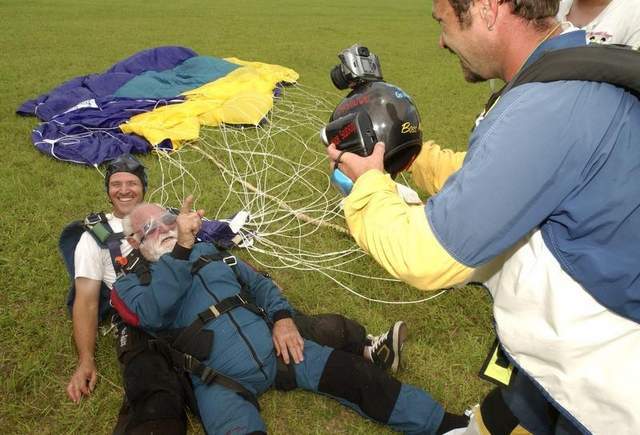
This week a woman fell to her death from a high rise New York City apartment tower but there was another big fall death, that of 56 year old skydiving instructor James Horak, whose body was found in a swamp in Mississippi.
Horak had been a skydiving instructor for nearly 40 years, and completed over 8,000 jumps. He died while doing a tandem jump with a student from Kentucky, who is still in the hospital in critical condition.
Other Great Reads: Dealing with grief after an accidental death
“He was extremely safety-conscious,” said his wife. “He did it the right way or no way.”
And earlier this year, in May, a 62 year old skydiver plummeted to his death in a southern California backyard. He was reportedly part of a group of skydivers trying a multiple person maneuver. The man became entangled in a parachute and fell to the ground.
Just how common are skydiving deaths?
According to the United States Parachute Association, in 2012 there were 19 fatal skydiving accidents in the U.S. out of roughly 3.1 million jumps. That translates to one fatality for every 163,158 skydives. In the 1970s, there was an average of 42.5 skydiving fatalities per year. In the 1980s, the average was 34.1. You guessed it, you are more likely to be killed by getting struck by lightning, or stung by a bee.
Other Great Reads: Death from above: killed by falling coconuts, meteorites, hail and frozen airplane shit
The history of skydiving goes back much further than you probably imagine. In the year 90 B.C. in China there was an Emperor Shun whose father was trying to kill him. Shun sought shelter in a granary tower which his father then set on fire. The resourceful Shun created a crude parachute out of several large conical straw hats and jumped out of the tower, landing safely on the ground and escaping his father’s wrath.
A story from the 1100s in the city of Canton, in southern China, tells of an Arab man who stole a leg off a golden lacquered table. He escaped by climbing to the top of a mosque’s minaret, holding onto two umbrellas, and jumping.
Around 1495, Leonardo Da Vinci designed a pyramid-shaped, wooden framed parachute. Last century a man jumped using a parachute made from DaVinci’s design and survived.
The modern history of skydiving really began in late 18th century France, when Joseph Montgolfier jumped out of a hot air balloon with a parachute. He survived, and using parachutes to jump from hot air balloons then became a thing.
The first person to be killed while parachuting was a British man named Robert Cocking, a professional watercolor artist who had an amateur interest in science. He had witnessed a successful parachute jump in England by Frenchman André-Jacques Garnerin, the inventor of the frameless parachute, and was inspired to improve upon his design.
Garnerin had used an umbrella-shaped parachute that had swayed excessively from side to side during the jump. Based on a book about flight he had read, Cocking determined a cone-shaped parachute would be more stable. He spent many years developing his improved parachute, which consisted of a 107 foot inverted cone connected by three hoops. Cocking was scheduled to demonstrate his contraption at Vauxhall Garden, a leading venue for public entertainment in 19th century London. He was 61 years old at the time. On the evening of July 24, 1837 Cocking and his parachute ascended to a height of about 5,000 feet in a hot air balloon, then he jumped.
“It was immediately obvious that Cocking was in trouble,” reads the Wikipedia page on the man. “Though rapid, the descent continued evenly for a few seconds, but then the entire apparatus turned inside out and plunged downwards with increasing speed. The parachute broke up before it hit the ground and at about 200 to 300 feet off the ground the basket detached from the remains of the canopy. Cocking was killed instantly in the crash.”
It was later determined the design could have worked, but Cocking’s parachute was far too heavy (it weighed some 250 pounds) and his construction was flimsy, in particular, the stitching connecting the fabric to the hoops.
For a while, parachuting became unpopular.









